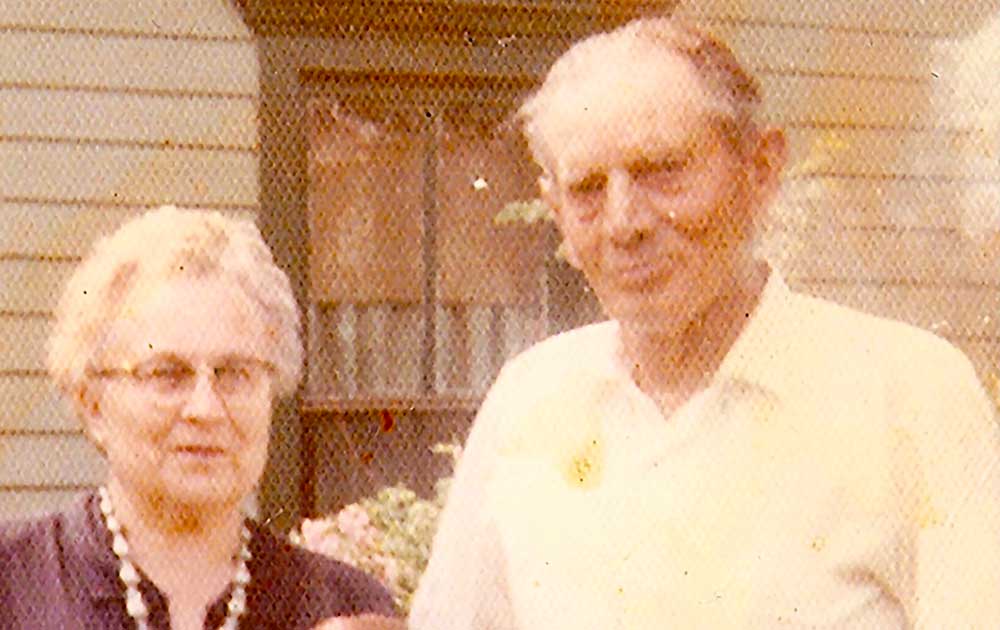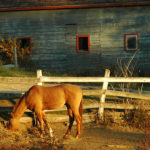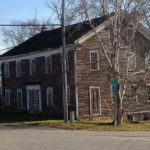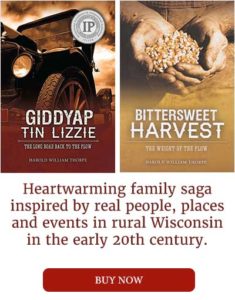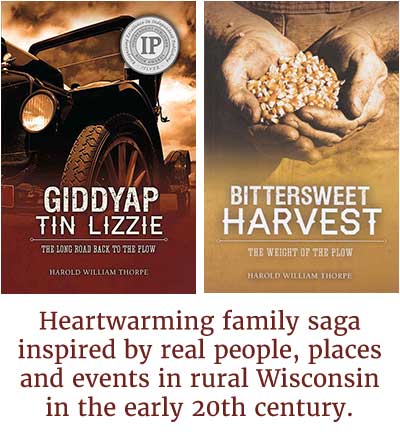
The following short story received a Nonfiction Honorable Mention in the 2021 Jade Ring Contest from the Wisconsin Writer’s Association
“As far as memoir writing, it doesn’t get much better than this. This reviewer encourages the writer to continue to tell the story of not only Aunt Anne and Uncle Earl but the other family members as well. They represent the fabric of those hard-working Americans who survived — and thrived — through the Dust Bowl and reflect others who have lived through hard times in America. The final sentence summarizes the story very well and drives home the endless truth that being financially rich isn’t everything.”
~ Laurie Scheer, Writing Mentor, 2021 Wisconsin Writers Association Jade Ring Contest Judge
Not a Dime in Their Pocket, By Harold William Thorpe, 1,977 words
My Cousin Dolores never saw her father cry—not until that day in 1936 when they stopped to visit his sister in Lamar, Colorado.
Uncle Mort and his family detoured to Lamar while on their way to visit his mother in California. The Great Depression blanketed the nation. Everyone was affected, but Mort knew that his sister suffered more than most others.
Several years earlier, the doctor gave Anne’s husband, Earl, two choices. Earl could go west to Colorado’s dry air or be committed to a Wisconsin TB sanitarium. That wasn’t a difficult decision. Anne and their three children joined Earl a year later; during the time that Southeastern Colorado was mired in the western Dust Bowl, while still in the midst of that depression. Their family struggled mightily to hang on.
Dolores told me, “Dad didn’t want us to come with him into their shack. He said that he’d go first, and then, he’d call us in if he decided it wouldn’t be too disturbing.” She said that he stayed for a long time, but upon returning to them, once out of sight, he slumped against the car and cried. He told Aunt Ruby and his daughters, Dolores and Phyllis, that Anne’s cupboards were almost bare. She had no milk for the children and no money to buy anything. Mort left some money and then continued his journey west.
My mother and father joined Aunt Anne and Uncle Earl in Colorado when I was two years old. Earl had recovered sufficiently from his TB to return to work. Dad worked with Uncle Earl on the Caddoa Dam for awhile before Dad decided to leave and try to find work in California. But sometime after we’d left Colorado, Earl was pitched off a ladder when a high-up rung broke. He tumbled twenty feet to the cement platform below, breaking both of his heels. Earl and his family encountered more adversity than most, but like others throughout the nation, they endured and fought their way back.
Although life never became easy for Anne and Earl, over the years I received from them a treasure trove of love, happy memories, and life lessons.
I was seven years old when we returned from California. We stayed at Aunt Anne’s for a month until we found a place of our own. Earl’s father had retired from dairy farming and moved to town. Anne and Earl took over the home farm which was located almost on top of a major highway.
Aunt Anne and Uncle Earl weren’t much better off financially than they’d been in Colorado, but they had one big advantage. With an abundance of milk, they harvested vegetables from their garden and butchered animals to provide table food, so no one went hungry.
Ten of us lived together for awhile: Anne and Earl and their two younger children, Wayne and Barb, plus their oldest daughter and her husband; Mother, Father, me and my sister.
My mother and Anne’s oldest daughter lent a hand with the cooking, but after early milking, Earl often helped with the breakfast. He loved to prepare what he called cold fries, the prior night’s leftover boiled potatoes, sliced thin and pan fried. He’d add some meat, usually bacon pieces, to the mix. I agreed with Earl’s choice; it made a delicious and substantive meal to kick off the day.
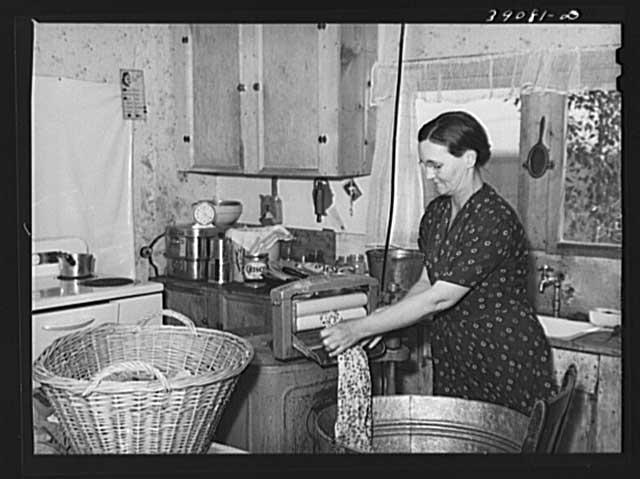
While Earl earned meager money working away, Anne barely kept the family afloat running a public laundry. Unlike the lady in this photo, she had no machine. She scrubbed clothes on a laundry board in a big washtub, bleached whites in another wash tub, and hung them outdoors to dry.
They had indoor plumbing, but it didn’t always work. One of the men frequently carried buckets of water from the well to provide a flush. The furnace was balky, so Earl spent a good amount of time in the basement trying to keep it going. Even though their life wasn’t easy, Anne and Earl did all they could to make us comfortable.
With a modest dairy farm income, Earl’s fortunes improved enough to enjoy a few of life’s pleasures. I visited frequently during the next ten years and learned valuable life lessons during those times. Perhaps the most important, I learned that helping others was a major feature of Anne and Earl’s lives. Earl was a skilled mechanic. He began his life-work as a filling station operator and mechanic. After losing his station through a shady transaction by a colleague, he went to work as a mechanic in Uncle Mort’s trucking company. That’s when he contracted TB and was sent to Colorado.
But he never forgot those mechanic’s skills. I don’t believe I ever spent time at his home without seeing him helping a marooned motorist. Living next to the highway, his was a natural stopping place for stranded motorists. More often than I could keep track of, he was outside working on a stranger’s engine. If they had a family in their car and if the car repair was going to take a while, Aunt Anne would invite them into the house for coffee, cool aide, and a sandwich. They never charged a cent for their help.
Others would stop because they’d run out of gas. Earl would sell them enough from his tank for them to drive three miles to a local station. Some who’d walked a ways to get to Earl’s yard needed a can to carry the gas back to their car, so Earl loaned them a gas can, too. Of course, they promised to return the can, but he frequently had to buy a new one. When they didn’t have the money to pay for the gas he’d given them, they’d promise to return to pay, but they often forgot. Even so, I never saw Earl turn anyone away.
Aunt Anne and Uncle Earl were a second pair of parents to me. I ate dozens—and dozens more—of Aunt Anne’s meals. When we’d ask, Aunt Anne would drop everything to play a game with us kids. Sometimes, Uncle Earl found a special treat that he liked—like limburger cheese on soda crackers—and he’d ask me to join him. I was not a fan of limburger cheese then or now, but when Uncle Earl invited me, I was right there beside him. That cheese wasn’t bad at all—not when Uncle Earl was there with me. Each Christmas was the same. Aunt Anne and Uncle Earl enjoyed their annual Christmas Eve treat—oyster stew. I hated oysters, but I ate that stew with Aunt Anne and Uncle Earl—although, admittedly, you had to search to find an oyster in the bowl.
Aunt Anne and Uncle Earl taught this young boy about important things in life—not the least, a strong work ethic. Aunt Anne taught me to make straight rows when we planted her garden each spring. She showed me how to string baler twine from the stake she’d driven on one side of the garden to the stake on the other side. We’d then dig holes or furrows and drop the seeds under the twine line. She’d then measure the distance from one set of stakes to a new set, before stringing those stakes with twine. But the work didn’t stop when the garden was planted. I’d frequently return To Aunt Anne’s during the summer. A hoe lazed beside the back door, patiently waiting for me to reintroduce it to its lifelong work.
And in late summer, when the berries hung crimson-black on the vine, Aunt Anne, Barb, and I would grab pails and head to the wooded hollow below the farm buildings to spend a day picking that juicy, luscious fruit. But my lesson didn’t end there, not by a long shot. A full day of picking produced two days of canning fruit for the winter’s desserts. I helped Barb wash Mason jars in preparation for the canning.
Each October, Uncle Earl gave me a food preparation lesson of a different kind. My hands were almost clean from the blackberry stains when he introduced a new stain that was many times more potent—the brownish-black dye from the black walnut husk, a dye so irremovable that it still marked my hands at Christmas time.
Uncle Earl had several tall Eastern black walnut trees on his land. They looked as if they were higher than his barn. We’d gather buckets of nuts and bring them back to the house. But it wasn’t a two inch brown, corrugated nut that we loaded into our buckets, it was a nut covered by a brownish-green, semi fleshy husk that was twice as thick as the nut. And that husk clung to the nut tighter than the bark on a tree. What’s more, anyone had to be super careful when removing it; otherwise they’d have black hands at Christmastime, too.
Uncle Earl taught me a trick that helped remove the husk somewhat easily, and helped keep your hands fairly free of the black dye—if you were careful. He produced a pipe with a two inch inside diameter, placed the husk covered nut on top of the pipe, and slammed the nut down into the pipe with his hammer. The nut plunged into the pipe, and the husk peeled off down the pipe’s exterior. Eventually the two inch nut, driven down by the nuts that followed, emerged from the bottom end of the pipe mostly free from husk pieces. But that didn’t complete the preparation. We’d load those husk-free nuts back into pails and carry them up to his attic. Once there, we spread them on newspapers to dry out over winter.
Even after all this effort, there was more work to be done come spring. It was Barb’s and my job to pick those earthy tasting nut pieces out of their hard shells, so hard that a nutcracker couldn’t dent them. Uncle Earl had a special vice that when slowly tightened down would break the shell, leaving the nutmeats exposed so that we could pick them from the broken shells. But you had to be careful, because if you cranked too hard, the shell pieces would be squashed into the nut meat, and Uncle Earl didn’t have a pipe that would separate that mixture. So much work for so little food—but those black walnut meats dotting the brown sugar frosting on a moist banana cake was my favorite dessert.
Every so often on Saturday night, Uncle Earl would drive to town and buy several pints of ice cream. He’d cut those pints in half and we’d each get to pick our favorite flavor. That half pint of ice cream was a delightful extravagance for this appreciative youngster.
Although movies were a rare treat for this young boy, Anne, Earl, Barb and I would sometimes jump into their car and head to the local theatre to see one of our favorite cowboy films—and now and then we’d be treated to a Pa and Ma Kettle movie. Pa and Ma were Barb and my favorite movie couple, maybe because they reminded us of Aunt Anne and Uncle Earl—mostly their appearance. Pa was so slim that he could slip into his barn through a missing board. If the door was wide enough, Ma entered that way.
Aunt Anne would occasionally sit at her piano and belt out some tunes. When she selected a lively piece, Uncle Earl would take center stage and dance a jig. Given his painful heels, it must have been hard, but he seemed to forget the hurt when the music got into him. You’d think he was a twenty year old hepcat when he jumped off the couch to cut the rug.
I doubt that Uncle Earl and Aunt Anne ever had more than the current month’s earnings in their bank account, but it didn’t require much money to show a lifetime of kindness to family, friends and strangers. Not a dime in their pocket, but if kindness has value, Aunt Anne and Uncle Earl were the richest people I knew.

